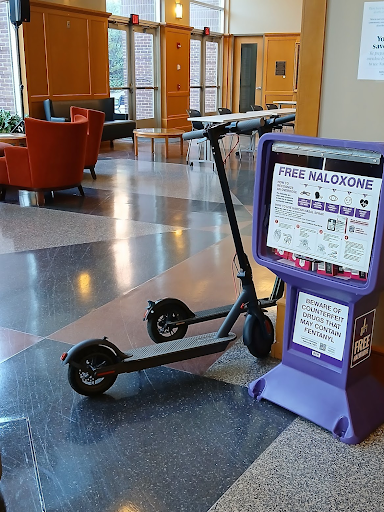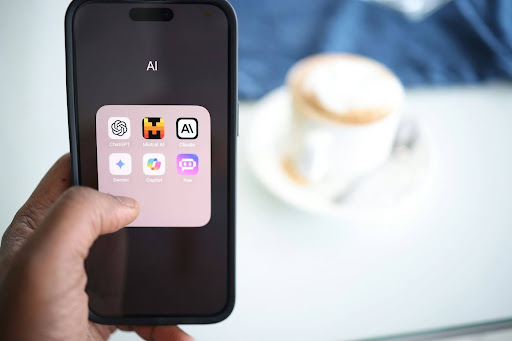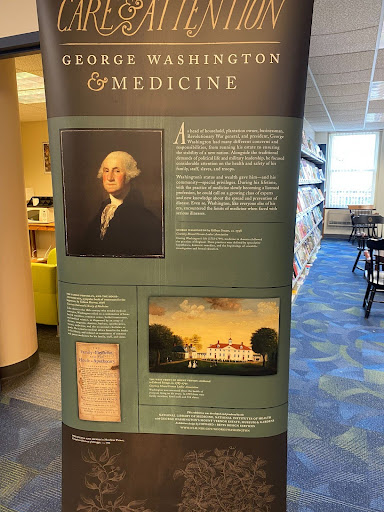
From Feb. 4 to March 15, Reeves Library hosted a traveling exhibit that explores George Washington’s connection to the Bethlehem Moravians during the Revolutionary War.
Titled “Every Necessary Care and Attention: George Washington and Medicine,” the exhibit was produced in collaboration with the National Library of Medicine and George Washington’s Mount Vernon Estate, Museum, and Gardens. The exhibit travels to various locations throughout the country.
In addition to Moravian, the exhibit has been hosted by the College of Southern Idaho Library in Twin Falls, New York State’s Hornell Public Library, and the HealthPartners Institute in Bloomington, Minnesota.
The exhibit focused on Washington’s attention to health practices that he believed promoted his own well-being and that of his staff, slaves, and soldiers. The first president’s interest was forged during a time when medicinal treatments were more primitive. The exhibit demonstrated how far the world of medicine has come since the 18th century by showcasing many of these older items that were used for treatments.
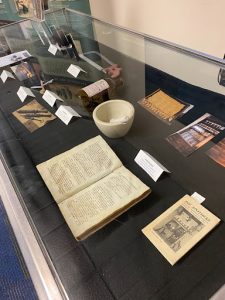
On display are a variety of medical items that were common to the Revolutionary War period, including “bonesaws,” which were used to perform amputations, and “medicine grinders.” Otherwise known as mortar and pestle, the grinders were used to mash medicinal herbs and other hard materials into a ground dust or paste to create medicines. Visitors can also view a fleam, a three-bladed medical instrument used for bloodletting.
Prominently displayed next to the mortar and pestle is a bottle of laudanum, a concoction made out of mostly alcohol with a bit of opium mixed in. Laudanum was often used in surgery to prevent patients from feeling pain during surgical operations. Dosages were to be carefully monitored as in high enough quantities, laudanum is poisonous.
A few books were also on display. Typically found in apothecaries, or what isare referred to now as pharmacies, the books give information on various medicines, including recipes and known treatments for ailments.
One of the photos on display showcased a couple of syringes. Syringes were used a lot more sparingly during the Revolutionary War era. When they were used, these syringes were mainly for administering enemas. This contrasts with the modern day, where syringes are used in drawing blood or administering medicines.
Another photo depicted some of the common weapons of the time: swords, flintlock pistols, and bayonets. There is one actual weapon on display, which is the cannonball. Canons were devastating weapons that could shoot three to six-pound metal balls at hundreds of miles per hour. Depending on where they hit, a cannonball could take off entire limbs or lead to instantaneous death.
Showcasing weaponry might seem antithetical to the theme of the exhibit, which is about medicine, but there is an important reason for doing this: it highlights the type of injuries soldiers were liable to receive. Amputation was a common medical procedure because there was not much else that could be done if a soldier’s arm was pierced by a bayonet and the cut got infected.
The items on display came from several different sources. Some physical artifacts, such as many of the books mentioned above, belong to the Reeves Library collection. A mortar and pestle, as well as many metal canisters, were on loan from Historic Bethlehem Museums & Sites. Some items were recreated by 3D printers.
A few digital resources were on loan from the National Library of Medicine.
On top of the display table was a small poster with a QR code. By scanning the QR code, those attending the exhibit could access supplemental information, including a curated research guide assembled by Moravian and the website for the National Library of Medicine. This website includes digital galleries, the exhibit’s traveling information, lesson plans for school curriculums, and more.
A highlight of the exhibit is a cabinet with some regimental uniforms for the British and the American Continental Armies. There are also a handful of additional items such as a pair of reading glasses, a tobacco tin, and a wooden canteen.
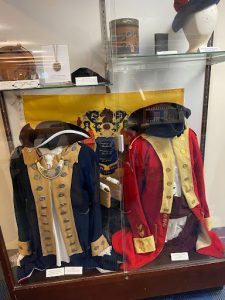
A number of Moravian students found the exhibit engaging and informative.
“The exhibit is very interesting and gives info on how diseases hindered the Continental Army as well as their enemies,” said history major Robert Homyak ‘28. “It helps me to understand how we have evolved not just in the way of warfare but also in the way of healing.”
Hal Grigsby, ’26 a history and Japanese double major, agreed. “The historical items in front of the exhibit helped give a sense of realness to the story. Often with history, it’s easy to dissociate the reality of the stories from the current state of our world,” he said. “However, being able to see artifacts right in front of us can combat that dissociation, and remind us of the circumstances that have led to our here and now.”
Grigsby did note the exhibit’s absence of any reference to slavery. “Washington owning over 300 slaves is an incredibly important item to keep in the dialogue, especially given how many of them were potentially trial patients for Washington’s health.”






